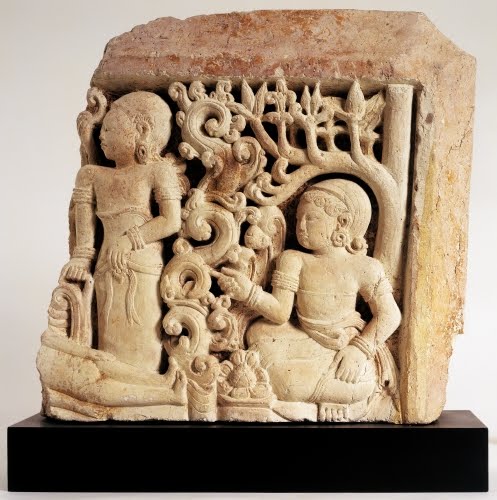An Art Ode to Labor Day Week: Majapahit Empire
I know that Labor Day is past, but we can keep it going throughout this week with a few works of art that represent the working class. The subject of labor has been a trend in art going all the way back to prehistoric cave paintings and rock carvings showing people tending to animals and hunting. I know going to a 9 to 5 job in contemporary life is not the same as hunting-and-gathering, but basically, we’re all doing it for the same reason—to survive.
 |
| Indonesia, Majapahit Kingdom, Woman with Attendant in a Garden, architectural relief fragment, 1300s. Chalk stone, 18" x 17 ¼" x 5" (45.7 x 43.8 x 12.7 cm). © 2017 Albright-Knox Art Gallery, Buffalo, NY. (AK-1241) |
I always get a bit of the sads when I see fragments of a once flourishing kingdom. The Majapahit empire flourished between about 1293 and about 1500/1513 in eastern Java. Wherever there’s a kingdom there are going to be rich people who have servants. Servants are performing about the most thankless labor imaginable—although I know from personal experience that waiting tables and working in a gas station aren’t much fun either! The deeply-carved reliefs of the Majapahit are as elegantly detailed as those in reliefs on the stupa at Borobudur in central Java, though slightly more stylized, especially the garden foliage. I can just hear this seated woman ordering her servant to do something!
It is generally believed that the earliest inhabitants of the Indonesian archipelago were of Indian or Burmese origin. Later migrants, known as Malays, came from Southern China and Indochina around 3000 BCE. Since the early period, the Javanese established trade with India and China. Prior to the arrival of Buddhism and Hinduism to Java, the native inhabitants practiced a form of animism.
Hinduism was introduced from India through trade during the first 100 years CE. Hindu kingdoms were established in Kalimantan, Sumatra, and Java between the 400s and the 1200s, some of which had also absorbed Buddhist influences. Javanese architecture began under Hindu influence, with a surge of Buddhism from about 750 to 850 (as evidenced by the monumental Stupa in Borobudur), and a second flourishing of Hindu architecture that lasted from the late 800s until the 1300s with the coming of Islam.
The Majahapit empire (kingdom) was an Indianized culture in eastern Java, Indonesia. The legendary “founder” of the kingdom was a prince Vijaya who was aided by Mongol troops from Yuan China to overthrow another ruler. The capital was established in Trowulan, which nowadays yields treasures of the Majapahit. The period of greatest power of the Majahapit kingdom was during the reigns of Queen Tribhuwana (1336–1350) and King Rajasangara (1350–1389). According to an old Javanese epic poem Nagarakretagama (ca. 1365), the Majapahit extended their control over Bali, Sumatra, Borneo, and New Guinea.
Some scholars assert that the kingdom only consisted of eastern Java and Bali, but records from Ming China delegations relate the wealth of the Majapahit kingdom, and it is thought to have had influence with Cambodia and Thailand, as well. The kingdom collapsed starting in the mid-1400s when the number of Islamic states began to increase along the northern coast.
Check back tomorrow for another artwork in honor of Labor Day.
Correlations to Davis programs: Explorations in Art Grade 3: 3.16; The Visual Experience: 13.3; Discovering Art History 4E: 4.5


Comments